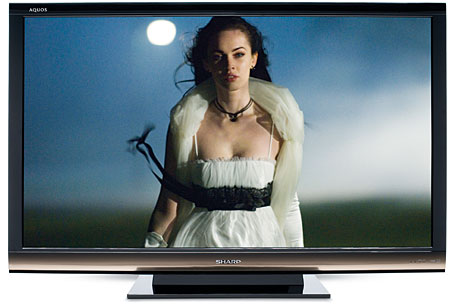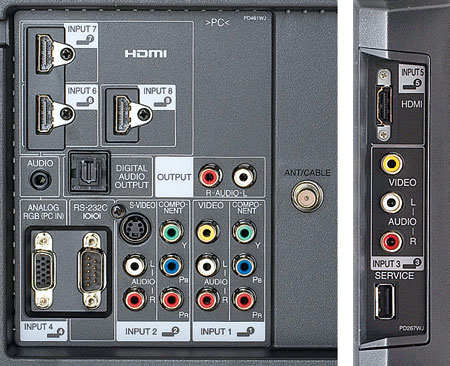Sharp LC-60E77UN LCD HDTV
A Worthy Contender

Many companies have gotten into the LCD HDTV game over the last few years, hoping to capitalize on the high demand for flat panels. But most are newcomers compared with Sharp, which was one of the first companies to offer LCD TVs in Japan back in 1988. Since then, Sharp has remained ahead of the curve in terms of manufacturing and environmental concerns. It has invested billions of dollars in new plants and processes.
Among the company’s current lines is the E77 series, which comes in several sizes, including the 60-inch LC-60E77UN reviewed here. This series offers basic LCD HDTVs at attractive prices for their sizes.
Features
The most obvious feature of the LC-60E77UN is 120-hertz operation—frames flash on the screen at a rate of 120 frames per second, which is twice the normal video rate of 60 fps and five times the film frame rate of 24 fps. In conjunction with a setting called Fine Motion Enhanced—Sharp’s frame-interpolation algorithm—this is intended to reduce the motion blur that has plagued LCD TVs since their introduction.
Frame interpolation creates new frames to insert between the actual frames in a video signal, calculating where moving objects should be in those new frames to smooth out the motion and sharpen the image. But this process can introduce artifacts of its own. Most 120-Hz and 240-Hz LCD HDTVs offer several degrees of interpolation, so you can balance the increased sharpness with any artifacts that might intrude. However, the LC-60E77UN’s Fine Motion Enhanced control has only two settings—On and Off.
As I mentioned earlier, Sharp has been making LCD TVs for a long time. That includes the LCD panels themselves, which, in the case of the E77 series, use 10 bits to represent each primary color (red, green, blue). This results in smoother color gradations and less solarization (banding in areas of subtle gradations) than the 8-bit panels used in lesser sets can manage.
One upscale feature found in the LC-60E77UN is a color management system (CMS). Unlike last year’s implementation, this one lets you tweak the hue, saturation, and brightness of each primary (red, green, blue) and secondary (yellow, magenta, cyan) color, moving the color points as needed. (Last year’s models didn’t have a brightness control for each color.) This is a potentially great feature, but you shouldn’t attempt to use it without the requisite tools and training.

I’m at a loss to understand this TV’s Monochrome mode, which disables all color and produces a black-and-white picture. What’s the point? More importantly, why not make this a blue-only mode, which would be a tremendous help in setting the color and tint controls? Without this mode, you must set these controls by looking at skintones, since blue filters don’t work reliably with LCD HDTVs.
Like many modern HDTVs, the LC-60E77UN includes several dynamic enhancements, such as automatic backlight and contrast adjustments that respond to the picture’s overall brightness (technically called average picture level or APL). These functions are intended to increase the contrast ratio and deepen the perceived black level. I normally find them to be more distracting than help- ful, so I left them off.
The backlight can also dynamically respond to the amount of light in the room, which can be more beneficial than adjustments based on APL. In particular, the best backlight setting for a brightly lit room is higher than the best setting for a darkened room. Also, if you engage this function, which is called Optical Picture Control (OPC) in Sharp TVs, it can save substantial amounts of energy. Enabling the dynamic APL response can save even more energy, but I don’t like the way it looks, so I’ll take a slight energy hit for the sake of a better picture.




























































